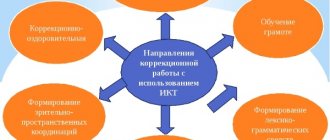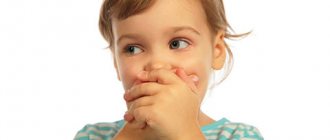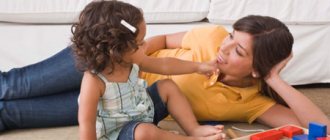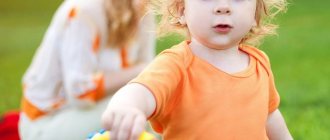A speech therapy examination of children 4-5 years old is necessary to determine the level of their speech, communicative and emotional-volitional development. The study is carried out comprehensively and consists of an examination of the child’s speech and non-speech capabilities, analysis of anamnestic data and conversations with parents and teachers (if it takes place in kindergarten).
The topic will be complemented by our previous material on speech therapy massage for children.
Speech therapy diagnostics of preschool children
Speech therapy diagnostics consists of the following:
- Filling out the medical history card by the teacher and parents;
- Examination of the child’s fine, general and articulatory motor skills;
- Studying the volume of vocabulary (passive - understood, and active - pronounced) of the baby;
- Checking the state of grammatical structure, phonemic processes (perception, analysis and synthesis of sounds) and coherent speech.
Speech therapy diagnostics of a younger preschooler
Akimenko speech examination technique
In modern kindergartens, V. M. Akimenko’s technique is used for speech therapy examination of children with speech disorders. This is an automatic computer program that conducts testing and processes the received data. Diagnostics is carried out in 15 main sections, includes tasks for children, detailed instructions and methodological materials for a speech therapist.
Additional Information! After testing, the program allows you to make a speech therapy conclusion, make an accurate diagnosis of a speech disorder and outline the process of correctional work.
Study of the state of phonemic perception
The state of phonemic awareness is tested by playing "Parrot". The baby is given the task of repeating two sounds: ka - ga; pa - ba; ba - on. Then a complication occurs - you need to repeat not the sounds, but the words: bowl - bear, varnish - cancer.
Checking compliance with the pattern and sound-syllable structure of the word
Compliance with the pattern is the order of reproduction of syllables in a word. A preschooler can “cut off” difficult-to-pronounce sounds in his speech (ka - mouse), or rearrange them (barelina - ballerina). When examining five-year-old preschoolers, you can use words consisting of 3-4 syllables, as well as materials with a combination of consonants.
Child's classes with a speech therapist
Study of pronunciation and speech production
The study of pronunciation and speech production includes:
- study of the articulatory apparatus and articulatory motor skills;
- state of sound pronunciation;
- reproduction of individual sounds and words, as well as coherent speech.
In the methodology for examining the articulatory apparatus, special attention is paid to the organs of articulation: tongue (long, short); teeth; soft palate (gothic, high, normal); lips (normal, cleft lip, thin, thick). Articulatory motor skills play an important role in pronunciation. Basic exercises: tongue with a spatula and a needle, puff out your cheeks, smile and make a straw with your lips.
Development of the prosodic aspect of speech in preschool children
Speech therapy diagnostics carried out for children 3-4 years old include a large number of exercises performed by imitation - the speech therapist shows them and then performs them together with the child. In older preschool age, preschoolers perform tasks from memory and only practice new exercises with an imitation teacher (however, they should not be included in the speech therapy examination).
Additional Information! The state of pronunciation and speech reproduction is checked using pictures using the task method: “Show me where...”. There should be a lot of picture material for every sound and syllable.
Test
No. 1. Association to a given word. It is necessary for the child to name a logically appropriate association for the given words.
- Table -
- Ball -
- Masha -
- Kitty -
- I'm reading -
- Blue -
Result: the task is considered completed if at least 3 correct answers are named (i.e., associations that are appropriate in meaning to the given word).
No. 2. It is necessary to select an associatively suitable noun for the phrases listed below.
- The boy pushes.
- Mom rocks.
- The bunny is eating.
- Grandma is cooking.
- Grandfather is reading.
Result: the task is considered completed if 5 correct answers are given
No. 3. It is necessary to select an associatively suitable verb for the phrases listed below.
- What is the dog doing?
- What does mom do?
- What is the bird doing?
- What is dad doing?
- What is the baby doing?
Result: the task is considered completed if 5 correct answers are given
No. 4. It is necessary to select an associatively suitable adjective for the phrases listed below.
- What cat?
- What mouse?
- What summer?
- What orange?
- What trees?
Result: the task is considered completed if 5 correct answers are given.
No. 5. Testing the ability to grammatically change words. What is a small ball called? What if there are several of them? What is a small mouse called? What if there are a lot of them? What do you call a tiny orange? What if there are several of them?
Result: the task is considered completed if 2 correct answers are given
No. 6. You must make a sentence based on one word (a sentence of at least 3 words).
- Girl
- Bunny
- Mother
Result: the task is considered completed if 2 correct answers are given.
No. 7. You need to make a sentence using 3 words
- Mom, stove, food.
- Uncle, axe, firewood.
- Dress, doll, girl.
Result: the task is considered completed if 3 correct answers are given.
No. 8. Level of verbal logical thinking. Sentences need to be supplemented.
- She came when...
- He didn't go for a walk because...
- She didn't take the doll, which...
- He entered a room in which...
Result: the task is considered completed if 4 correct answers are given.
No. 9. Correcting grammatical errors in sentences by changing their constructions. It is necessary to warn the child that now you will name sentences with errors, and he must redo them.
- She went outside.
- There I saw a big truck.
- There were people standing at the traffic light.
- A little girl was crossing the road.
Result: the task is considered completed if 3 correct answers are given (any of the possible correction methods is counted).
No. 10. An explanation of the sequence of an action.
- Tell me the rules of the game that you know how to play and love to play.
- How to consistently dress for the street in winter?
Result: the task is considered completed if a complete and clear explanation of one of the actions is received.
No. 11. Knowledge of the basic elements of the language.
- Name any one word.
- Make any one sound.
- Make a proposal.
Result: the task is considered completed if 2 correct answers are received.
No. 12 Constructing a statement with conditions. It is necessary to inform the child that you will ask questions, and he must answer without using certain words in brackets.
- What is the cow doing? (cow mooing).
- What does a cat like? (cat, milk).
- What wolf? (wolf, evil).
Result: the task is considered completed if 2 correct answers are received (answer with at least 2 coherent words).
Sum up the number of tasks completed.
How is a speech therapy examination performed for children with speech disorders?
The Psychological-Medical-Pedagogical Commission (PMPC) conducts a comprehensive speech therapy examination for children with speech disorders in order to issue the correct conclusion and subsequent correction in a specialized kindergarten. The examination is divided into stages:
- Conversation with parents and filling out an anamnesis card (child development before birth and the first 3 years of life).
- Studying the child’s motor skills and his organs of articulation. At this stage, the child’s mental characteristics (communication, behavior) and the type of breathing used by the baby are also noted.
- The level of violations of sound pronunciation, grammatical and lexical structure of speech is revealed.
- Diagnosing disorders in coherent speech, as well as determining the volume of passive (understood) and active (pronounced) vocabulary.
Psychological-medical-pedagogical commission
Main examination criteria (type, volume, smoothness of non-speech and speech breathing, duration of speech exhalation).
In speech therapy in children, there are 3 types of breathing: thoracic (as you inhale, the chest expands), diaphragmatic (normal) and clavicular (shoulders rise). Determined at rest, the baby should sit, lie or stand.
The volume and strength of the air stream are revealed using exhalation exercises - blow on a dandelion (in spring and summer) or special speech therapy material (you can print out a flower and “plant” a ladybug on it, which needs to be blown away).
The smoothness of non-speech and speech breathing is determined by the consistency of stops in the child’s speech. And the duration of speech exhalation is the number of words that a child can pronounce on exhalation (at four years old this is 5-7 words normally).
Additional Information! It is important to actively develop a child’s breathing in early preschool age. This can be done with the help of special exercises from the teaching aids for the Federal State Educational Standard.
Physiological characteristics and imperfections in sound pronunciation in preschool children
At the age of 4-5 years, children usually have all their baby teeth. Imperfections in sound pronunciation may be due to low mobility of the articulatory organs and the special structure of the articulatory apparatus.
It is considered normal if a preschooler by the age of 5 does not yet have complex sounds such as “r”, “sh” and “l”. After a year or two, they can stand up on their own, without speech therapy help.
Children's speech by age
Study of the state of impressive (understandable) speech
The state of impressive speech is carried out using didactic material and special aids. The teacher calls the object: “Show me the plane,” the child must point to it.
Testing of non-speech mental functions
Testing of non-speech mental functions includes the following studies:
- state of sound perception (where the sound comes from, differentiation of musical instruments);
- state of visual perception (show a certain color, shape);
- completeness of motor skills (manual, general, fine, articulatory).
Anamnesis data collection questionnaire
In the anamnestic data collection questionnaire, the main questions are the following:
- nature of pregnancy;
- the presence of chronic diseases in parents and close relatives;
- injuries during childbirth;
- injuries within 3 years of life;
- basic skills (at what time the child raised his head, began to sit, stand and walk, uttered the first sounds and words).
Speech therapy examination of a non-speech child
The examination should be unobtrusive, since non-verbal children are often susceptible to aggression. You can’t tell your baby: “Repeat, tell me.” Instead: “Show me.”
For example: The state of phonemic awareness of a non-speech child is checked using sets of pictures.
Assignment: “Show me where the bowl is? Where’s the bear?”
Materials for the task: bowl, bear, kidney, barrel, crayfish, varnish, eyes, thunderstorm, goat, scythe.
To increase the interest of modern children in classes, instead of the usual didactic materials in pictures, you can make a presentation on electronic media.
Study of the state of respiratory and vocal functions
In the state of respiratory and vocal function, the type of breathing (thoracic, clavicular, diaphragmatic), the strength and smoothness of the air stream and the number of words pronounced on exhalation are noted (the norm by 5 years is 5-7 words).
Study of nonverbal components of communication
As non-verbal components of communication, non-speech children most often use gestures (pointing with fingers, hand), facial expressions and onomatopoeia or sound complexes (one sound, for example “ta”, may have several definitions - doll, dog, car, etc.). To develop speech, you should not go deep into their study, but you need to pay attention to exercises that “trigger” the child’s speech.
Additional Information! A good guide for homework would be T. A. Tkachenko’s book “Speech Therapy Exercises,” intended for preschoolers aged 4-7 years.
Nonverbal Components of Communication
Speech therapy examination is an important part of the development and formation of children’s speech. In the process, possible speech disorders are identified and methods for their correction are immediately prescribed (classes with a teacher, or referral to a specialized kindergarten).
Calculation of the result
The formula for calculating the level of speech development: BRR = KVR x 100 / KV, in which:
- BRR—speech development score;
- KVR—developmental age coefficient;
- KA - calendar age of the child.
We multiply the number of correctly completed tasks by 6 (the number of months to complete each of the 12 tasks) and get the CVR.
The EF is equal to the number of full months of the child’s age from birth to the date of the test (if the remainder is more than 15 days, it is counted as a full month).
For example, if the child’s age at the time of testing is 6 years 4 months 20 days, then his EF is 77.
The BRR number indicates the degree of general speech development in a child.
For example:
The kid completed 9 tasks, his calendar age is 77. As a result, we get: BRR = 9x6x100/77 = 70,123 = 70 We compare the obtained result with the BRR matrix.







